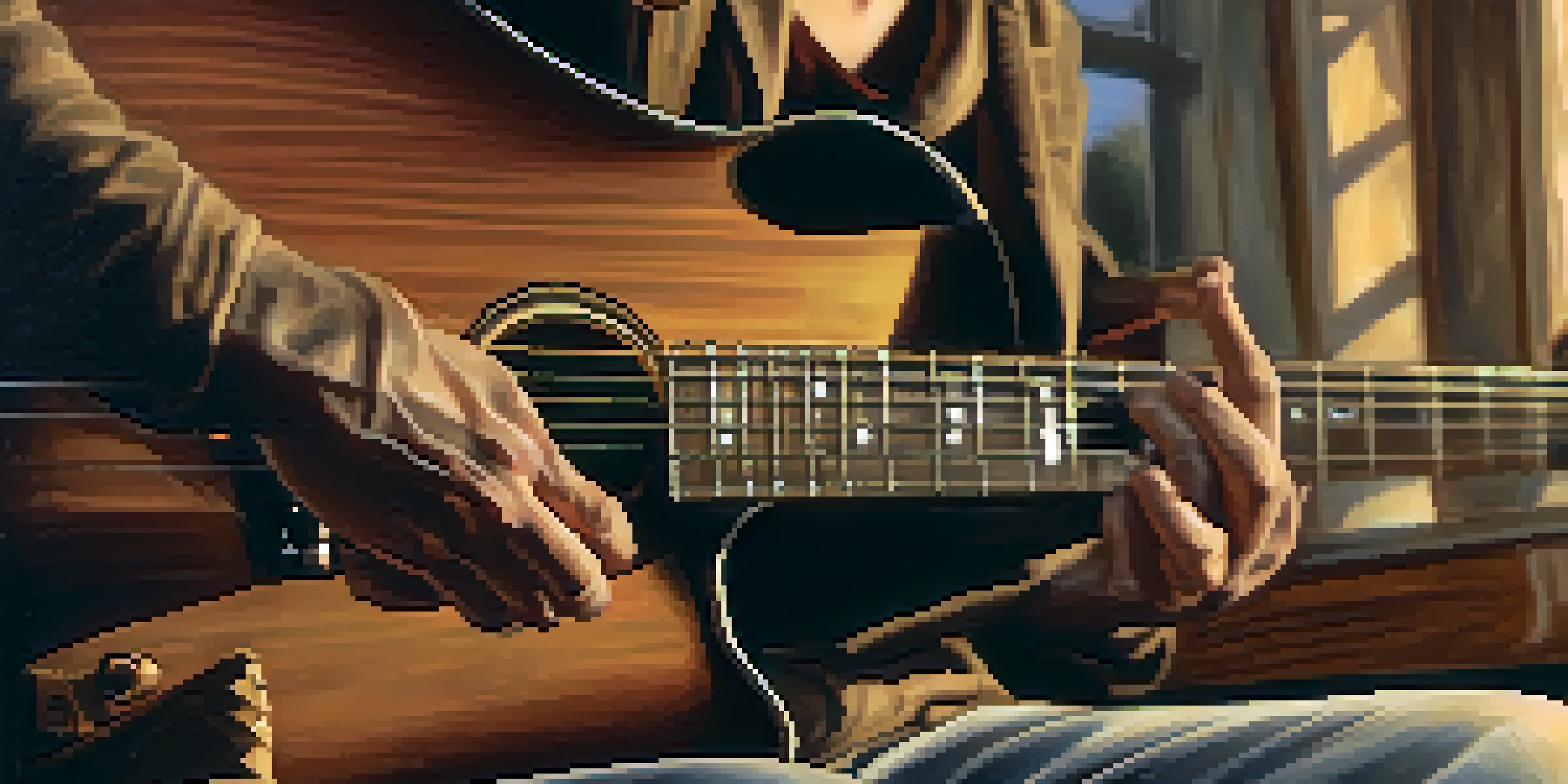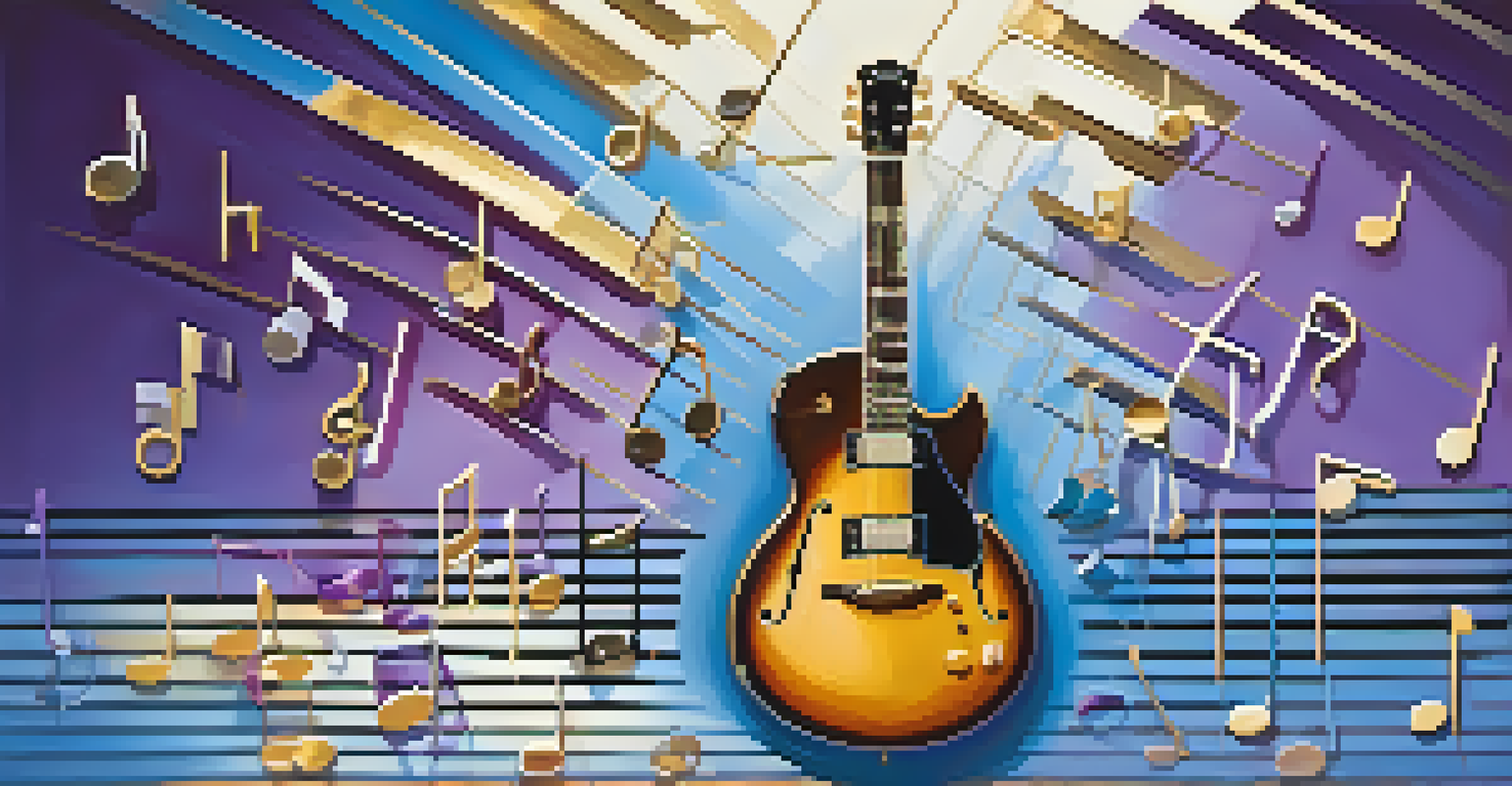Understanding Major Guitar Scales: Patterns and Melodic Use

What Are Major Guitar Scales and Why They Matter
Major guitar scales are foundational tools for musicians, providing a framework for creating melodies and harmonies. They consist of seven notes, with the major scale being one of the most common scales used in Western music. Think of it as the starting point for countless songs across genres, from pop to classical.
Music is the shorthand of emotion.
Understanding major scales gives guitarists the ability to improvise and compose effectively. When you know the scale, you can easily identify which notes will sound harmonious together. This knowledge opens up a world of creative possibilities, allowing you to express emotions through your playing.
Moreover, mastering major scales enhances your overall musicality. It helps you develop your ear for music, making it easier to recognize melodies and chord progressions. In essence, these scales are not just patterns; they’re keys that unlock your potential as a guitarist.
The Structure of Major Guitar Scales
Major scales follow a specific pattern of whole and half steps, which creates their unique sound. The pattern is whole, whole, half, whole, whole, whole, half, leading to a distinct tonal quality. For example, the C major scale starts on C and follows this pattern: C, D, E, F, G, A, B, and back to C.

This structure is crucial for understanding how to navigate the fretboard. By visualizing these patterns, you can easily find the notes in different keys. It’s like learning a map; once you know the routes, getting from one point to another becomes second nature.
Importance of Major Scales
Major guitar scales are essential for musicians, forming the backbone of melody and harmony in various musical genres.
Additionally, recognizing these patterns helps you transpose scales to different keys. If you’re comfortable with the C major scale, you can apply the same pattern to D, E, or any other note. This versatility is essential for playing with other musicians and adapting to various musical contexts.
Common Major Guitar Scale Patterns
There are several common patterns that guitarists use when playing major scales. One of the most popular is the three-note-per-string pattern, which allows for fluid movement across the fretboard. This pattern not only facilitates faster playing but also aids in developing finger strength and dexterity.
The music is not in the notes, but in the silence between.
Another widely used pattern is the two-octave scale, which provides a broader range of notes. This pattern is particularly useful for improvisation, as it gives you access to more melodic options. By practicing these patterns, you’ll find that your comfort level with the guitar increases significantly.
Lastly, incorporating arpeggios into your practice can enhance your understanding of major scales. An arpeggio breaks down the scale into individual notes played in succession, allowing you to hear how they work together melodically. This approach builds a solid foundation for both playing and composing.
Using Major Scales Melodically
Once you grasp the patterns of major scales, you can start using them to create melodies. Melodic improvisation involves selecting notes from the scale to express your musical ideas. It’s akin to painting with sound, where you choose colors (notes) that resonate with your emotions.
A great way to start is by creating simple motifs or phrases using the notes of the major scale. These can serve as the building blocks for more complex melodies. Think of it like writing a sentence; your motifs are words that, when combined, create beautiful musical stories.
Structure and Patterns Matter
Understanding the specific patterns and structures of major scales allows guitarists to navigate the fretboard and transpose easily.
Experimenting with rhythm and phrasing while using major scales can also enhance your melodic creations. By varying the duration and timing of your notes, you’ll develop unique musical expressions. This experimentation not only keeps your playing fresh but also deepens your connection to the music.
Incorporating Major Scales into Your Playing
Integrating major scales into your guitar playing can elevate your skills significantly. Start by practicing scales in different positions on the neck, which builds muscle memory and familiarity with the fretboard. This practice makes it easier to access notes during performances or jam sessions.
You can also incorporate scales into your practice routines by combining them with chords. For example, try strumming a C major chord while playing a C major scale. This approach helps you understand how scales relate to chords, deepening your overall musical comprehension.
Lastly, consider using major scales as a foundation for songwriting. Many songwriters begin with a scale to craft melodies and harmonies. By using the major scale as your starting point, you can create songs that resonate with listeners and showcase your unique style.
Tips for Practicing Major Guitar Scales
Effective practice is key to mastering major guitar scales. Start slow, focusing on accuracy before you increase your speed. This method ensures that you develop a solid foundation, making it easier to play complex patterns later on.
Incorporating a metronome into your practice can significantly improve your timing and rhythm. Begin at a comfortable tempo, gradually increasing the speed as you become more proficient. This approach not only enhances your technical skills but also prepares you for playing with other musicians.
Practicing for Mastery
Effective practice techniques, such as starting slow and using a metronome, are crucial for mastering major guitar scales and enhancing musical expression.
Lastly, don’t forget to have fun while practicing! Incorporate your favorite songs that use major scales into your routine. This will keep you motivated and engaged, making the learning process feel less like a chore and more like an enjoyable journey.
Conclusion: The Journey with Major Scales
Understanding major guitar scales is a journey that enhances your musicality and creativity. As you explore these patterns, you’ll find that they not only improve your technical skills but also unlock new avenues for expression. The more you practice, the more confident you’ll become in your playing.
Remember, the key is to stay curious and keep experimenting with different sounds and techniques. Whether you’re improvising, composing, or simply playing for fun, major scales provide a solid foundation for all your musical endeavors. Each scale you master brings you one step closer to becoming the guitarist you aspire to be.

So grab your guitar, dive into the world of major scales, and let your creativity flow. With patience and persistence, you'll find that these scales are not just notes on a page, but a gateway to your musical expression.